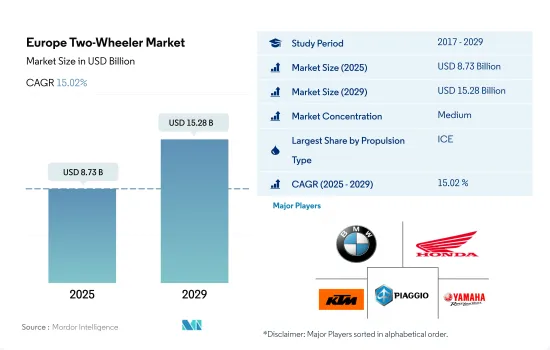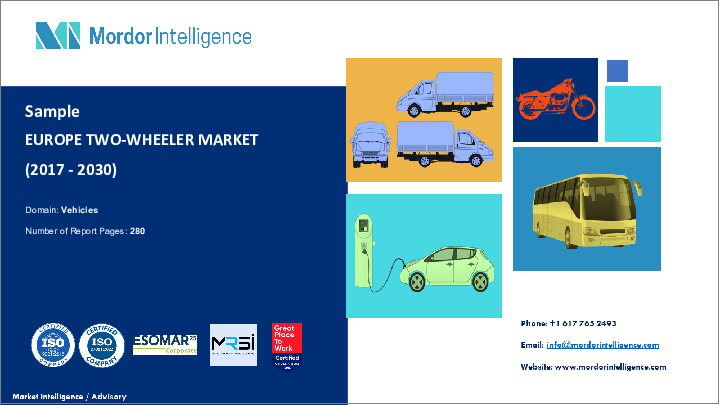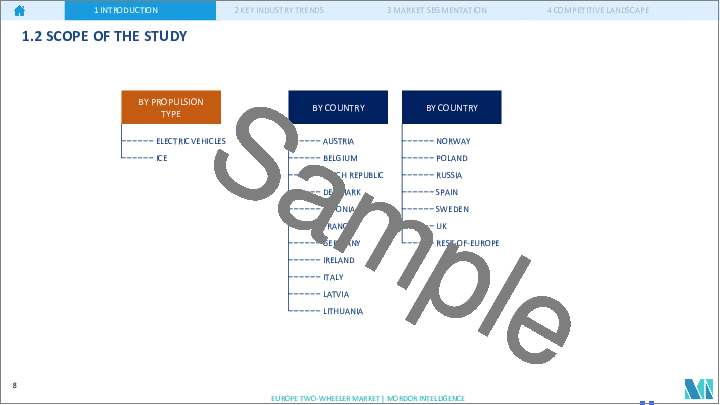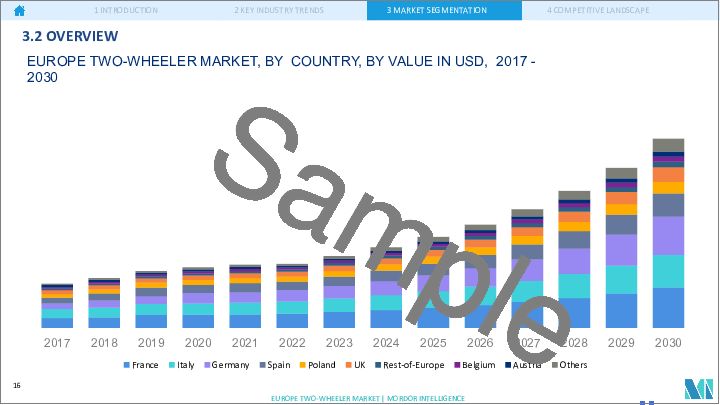|
|
市場調査レポート
商品コード
1684107
欧州の二輪車市場:シェア分析、産業動向・統計、成長予測(2025年~2029年)Europe Two-Wheeler - Market Share Analysis, Industry Trends & Statistics, Growth Forecasts (2025 - 2029) |
||||||
カスタマイズ可能
適宜更新あり
|
|||||||
| 欧州の二輪車市場:シェア分析、産業動向・統計、成長予測(2025年~2029年) |
|
出版日: 2025年03月18日
発行: Mordor Intelligence
ページ情報: 英文 218 Pages
納期: 2~3営業日
|
全表示
- 概要
- 目次
概要
欧州の二輪車市場規模は2025年に87億3,000万米ドルと推定・予測され、2029年には152億8,000万米ドルに達し、予測期間中(2025年~2029年)のCAGRは15.02%で成長すると予測されます。

欧州の二輪車市場の着実な成長は、技術の進歩、政策、消費者の嗜好の変化による電動化と持続可能性のシフトを意味します。
- 2023年、欧州の二輪車市場は成長パターンを示し、販売台数は125万6,184台と、前年の118万8,468台から増加しました。この成長は、都市化、より持続可能な通勤手段の模索、レジャー活動における二輪車の魅力の高まりに後押しされ、主要および二次的な交通手段として二輪車への関心が拡大していることを反映しています。
- 欧州市場の拡大は、ハイブリッド車と電動二輪車の導入急増に大きく影響されています。この変化は、厳しい環境規制、よりクリーンな交通手段を促進することを目的とした政府のインセンティブ、二酸化炭素排出量の削減に対する消費者の意識の高まりなど、さまざまな要因の組み合わせによって支えられています。これらの要素と、バッテリー寿命の改善、充電時間の短縮、性能の向上といった電動二輪車技術の進歩が相まって、より幅広い層の消費者にとって電動二輪車の選択肢はますます現実的で魅力的なものになっています。
- 2024年から2030年にかけての予測データでは、欧州全域で二輪車の販売台数は着実に増加し、2030年には173万220台に達するという予測が示されました。この持続的な成長軌道は、柔軟で効率的かつ持続可能な交通手段としての二輪車の永続的な魅力を強調しています。電動二輪車の継続的な販売台数の増加は、輸送分野における電動化への幅広い動向を反映して、この成長に大きく貢献すると予想されます。
メーカーは、バッテリー技術、自律走行機能、コネクティビティの進歩により、より効率的で安全かつスマートな二輪車を導入するために研究開発に投資しています。
- 欧州の二輪車市場は、技術の進歩、消費者の嗜好の変化、環境問題への関心の高まりが相まって、著しい成長と変貌を遂げています。この市場には、二輪車、スクーター、モペット、電動二輪車など幅広い種類の自動車が含まれます。特に電動二輪車に対する需要の急増は、持続可能な輸送ソリューションに対するこの地域の取り組みの高まりを反映しています。このシフトは、政府のインセンティブ、排出規制の強化、電気自動車用インフラの拡大によってさらに後押しされ、消費者にとって電動二輪車がますます魅力的な選択肢となっています。
- 欧州の消費者の動向は進化しており、利便性、手頃な価格、環境負荷の低減を提供する都市型モビリティ・ソリューションへの傾向が顕著になっています。二輪車、特にスクーターや原付は、自動車よりも効率的に交通を通過でき、運行コストが低く、駐車が容易なため、都市交通の選択肢として人気を集めています。この動向は、二輪車のライドシェア・プラットフォームやレンタル・サービスの人気の高まりによって補完されており、二輪車を所有する必要なく、柔軟で費用対効果の高いモビリティ・ソリューションを提供しています。さらに、GPSナビゲーション、盗難防止システム、スマートフォンとの統合など、二輪車に搭載されたスマート・コネクティビティ機能の登場により、乗車体験が向上し、ハイテクに詳しい消費者にとって魅力的なものとなっています。
欧州の二輪車市場の動向
環境問題への関心、政府の支援、脱炭素化目標が欧州の電気自動車需要と販売に拍車
- 欧州諸国における電気自動車の需要と販売は、ここ数年で大きく伸びています。ドイツは2022年に電気自動車の販売台数が2021年比で22%増加し、次いで英国が2022年に2021年比で18.40%増加しました。環境問題への関心の高まり、政府の厳しい規範、燃費の良さ、サービスコストの低さ、二酸化炭素排出量の少なさといった電気自動車の利点、政府による補助金などが、欧州諸国における電気自動車の成長に寄与している要因のひとつです。
- 電気商用車、特に小型トラックの需要は、欧州諸国で徐々に伸びています。さらに、各国の政府も電気自動車の導入を支援しています。2021年11月、英国政府は2040年までにすべての大型車をゼロ・エミッションにするという公約を発表しました。このような要因により、英国における2022年の電気商用車販売台数は2021年比で23.17%増加し、各国の同様の慣行が欧州全域で電気商用車の需要を高めています。
- 欧州諸国における車両の電動化は、今後数年間で飛躍的に成長すると予測されています。脱炭素化に向けた各国政府の取り組みが、欧州の電気商用車市場を牽引すると予想されます。例えば、2022年1月、ドイツの運輸大臣は、2030年までに1,500万台の電気自動車を走らせるという目標を発表しました。こうした要因により、欧州諸国では2024年~2030年の間に電気自動車の販売が増加すると予想されます。
欧州二輪車産業の概要
欧州の二輪車市場は適度に統合されており、上位5社で41.80%を占めています。この市場の主要企業は以下の通り。 BMW Motorrad, Honda Motor, KTM Motorcycles, Piaggio & C. SpA and Yamaha Motor Company Limited.
その他の特典
- エクセル形式の市場予測(ME)シート
- 3ヶ月のアナリストサポート
目次
第1章 エグゼクティブサマリーと主な調査結果
第2章 レポートのオファー
第3章 イントロダクション
- 調査の前提条件と市場定義
- 調査範囲
- 調査手法
第4章 主要産業動向
- 人口
- 一人当たりGDP
- 自動車購入のための消費者支出(cvp)
- インフレ率
- 自動車ローン金利
- 電化の影響
- EV充電ステーション
- バッテリーパック価格
- Xev新モデル発表
- 燃料価格
- 規制の枠組み
- バリューチェーンと流通チャネル分析
第5章 市場セグメンテーション
- 推進タイプ
- ハイブリッド車と電気自動車
- ICE(電気自動車)
- 国名
- オーストリア
- ベルギー
- チェコ共和国
- デンマーク
- エストニア
- フランス
- ドイツ
- アイルランド
- イタリア
- ラトビア
- リトアニア
- ノルウェー
- ポーランド
- ロシア
- スペイン
- スウェーデン
- 英国
- その他の欧州
第6章 競合情勢
- 主要な戦略動向
- 市場シェア分析
- 企業情勢
- 企業プロファイル
- BMW Motorrad
- Ducati Motor Holding S.p.A.
- Harley-Davidson
- Honda Motor Co.,Ltd.
- KTM Motorcycles
- Piaggio & C. SpA
- Royal Enfield
- Suzuki Motor Corporation
- Triumph Motorcycles Ltd
- Yamaha Motor Company Limited
第7章 CEOへの主な戦略的質問CEOへの主な戦略的質問
第8章 付録
- 世界概要
- 概要
- ファイブフォース分析フレームワーク
- 世界・バリューチェーン分析
- 市場力学(DROs)
- 情報源と参考文献
- 図表一覧
- 主要洞察
- データパック
- 用語集
目次
Product Code: 50002259
The Europe Two-Wheeler Market size is estimated at 8.73 billion USD in 2025, and is expected to reach 15.28 billion USD by 2029, growing at a CAGR of 15.02% during the forecast period (2025-2029).

The European two-wheeler market's steady growth signifies an electrification and sustainability shift driven by tech advancements, policies, and changing consumer preferences
- In 2023, the European market for two-wheelers exhibited a growth pattern, with sales totaling 1,256,184 units, indicating an increase from the previous year's 1,188,468 units. This growth reflected an expanding interest in two-wheelers as both a primary and secondary mode of transportation, fueled by urbanization, the search for more sustainable commuting options, and the increased appeal of two-wheelers for leisure activities.
- The European market's progression is significantly influenced by the surge in hybrid and electric two-wheeler adoption. This shift is supported by a combination of factors, including stringent environmental regulations, government incentives aimed at promoting cleaner modes of transportation, and growing consumer consciousness towards reducing carbon footprints. These elements, coupled with advancements in electric two-wheeler technology-such as improved battery life, shorter charging times, and enhanced performance-are making electric options increasingly viable and attractive to a broader segment of consumers.
- From 2024 to 2030, the forecasted data indicated a steady increase in two-wheeler sales across Europe, with projections showing that sales could reach 1,730,220 units by 2030. This sustained growth trajectory underscores the enduring appeal of two-wheelers as a flexible, efficient, and sustainable mode of transportation. The continued rise in electric two-wheeler sales is expected to significantly contribute to this growth, reflecting a broader trend towards electrification in the transportation sector.
Manufacturers are investing in R&D to introduce more efficient, safer, and smarter two-wheelers with advancements in battery technology, autonomous driving features, and connectivity
- The European two-wheeler market has been witnessing significant growth and transformation, driven by a combination of technological advancements, changing consumer preferences, and increasing environmental concerns. The market encompasses a wide range of vehicles, including motorcycles, scooters, mopeds, and electrically powered two-wheelers. The surge in demand for electric two-wheelers, in particular, reflects the region's growing commitment to sustainable transportation solutions. This shift is further supported by government incentives, stricter emission regulations, and an expanding infrastructure for electric vehicles, making electric two-wheelers an increasingly attractive option for consumers.
- Consumer preferences in Europe have been evolving, with a noticeable trend toward urban mobility solutions that offer convenience, affordability, and reduced environmental impact. Two-wheelers, especially scooters and mopeds, have become popular urban transport options due to their ability to navigate through traffic more efficiently than cars, lower operating costs, and ease of parking. This trend is complemented by the growing popularity of ride-sharing platforms and rental services for two-wheelers, which offer flexible and cost-effective mobility solutions without the need for ownership. Additionally, the advent of smart connectivity features in two-wheelers, such as GPS navigation, anti-theft systems, and smartphone integration, has enhanced the riding experience, making them more appealing to tech-savvy consumers.
Europe Two-Wheeler Market Trends
Environmental concerns, government support, and decarbonization goals fuel European electric vehicle demand and sales
- The demand and sales of electric vehicles in European countries have grown significantly over the past few years. Germany witnessed a growth in the sales of electric cars by 22% in 2022 over 2021, followed by the United Kingdom with an 18.40% increase in 2022 over 2021. Growing environmental concerns, stringent governmental norms, advantages of electric vehicles such as fuel efficiency, low service cost, no carbon emissions, and subsidies by the government are some of the factors contributing to the growth of electric vehicles in European countries.
- The demand for electric commercial vehicles, especially light trucks, is growing gradually in European countries. Moreover, the governments of various countries are also supporting the adoption of electric vehicles. In November 2021, the government of the United Kingdom announced a pledge that all heavy-duty vehicles would be zero-emission by the year 2040. Such factors have increased the sales of electric commercial vehicles in the United Kingdom by 23.17% in 2022 over 2021, and similar practices in various countries are enhancing the demand for electric commercial vehicles across Europe.
- It is projected that the electrification of vehicles in European countries is expected to grow tremendously in the next few years. The efforts of the governments in the regions for decarbonization are expected to drive the electric commercial vehicle market in Europe. For instance, in January 2022, the transport minister of Germany announced a goal to put 15 million electric vehicles on the road by 2030. Such factors are expected to increase the sales of electric vehicles during the 2024-2030 period in European countries.
Europe Two-Wheeler Industry Overview
The Europe Two-Wheeler Market is moderately consolidated, with the top five companies occupying 41.80%. The major players in this market are BMW Motorrad, Honda Motor Co.,Ltd., KTM Motorcycles, Piaggio & C. SpA and Yamaha Motor Company Limited (sorted alphabetically).
Additional Benefits:
- The market estimate (ME) sheet in Excel format
- 3 months of analyst support
TABLE OF CONTENTS
1 EXECUTIVE SUMMARY & KEY FINDINGS
2 REPORT OFFERS
3 INTRODUCTION
- 3.1 Study Assumptions & Market Definition
- 3.2 Scope of the Study
- 3.3 Research Methodology
4 KEY INDUSTRY TRENDS
- 4.1 Population
- 4.2 GDP Per Capita
- 4.3 Consumer Spending For Vehicle Purchase (cvp)
- 4.4 Inflation
- 4.5 Interest Rate For Auto Loans
- 4.6 Impact Of Electrification
- 4.7 EV Charging Station
- 4.8 Battery Pack Price
- 4.9 New Xev Models Announced
- 4.10 Fuel Price
- 4.11 Regulatory Framework
- 4.12 Value Chain & Distribution Channel Analysis
5 MARKET SEGMENTATION (includes market size in Value in USD and Volume, Forecasts up to 2029 and analysis of growth prospects)
- 5.1 Propulsion Type
- 5.1.1 Hybrid and Electric Vehicles
- 5.1.2 ICE
- 5.2 Country
- 5.2.1 Austria
- 5.2.2 Belgium
- 5.2.3 Czech Republic
- 5.2.4 Denmark
- 5.2.5 Estonia
- 5.2.6 France
- 5.2.7 Germany
- 5.2.8 Ireland
- 5.2.9 Italy
- 5.2.10 Latvia
- 5.2.11 Lithuania
- 5.2.12 Norway
- 5.2.13 Poland
- 5.2.14 Russia
- 5.2.15 Spain
- 5.2.16 Sweden
- 5.2.17 UK
- 5.2.18 Rest-of-Europe
6 COMPETITIVE LANDSCAPE
- 6.1 Key Strategic Moves
- 6.2 Market Share Analysis
- 6.3 Company Landscape
- 6.4 Company Profiles
- 6.4.1 BMW Motorrad
- 6.4.2 Ducati Motor Holding S.p.A.
- 6.4.3 Harley-Davidson
- 6.4.4 Honda Motor Co.,Ltd.
- 6.4.5 KTM Motorcycles
- 6.4.6 Piaggio & C. SpA
- 6.4.7 Royal Enfield
- 6.4.8 Suzuki Motor Corporation
- 6.4.9 Triumph Motorcycles Ltd
- 6.4.10 Yamaha Motor Company Limited
7 KEY STRATEGIC QUESTIONS FOR VEHICLES CEOS
8 APPENDIX
- 8.1 Global Overview
- 8.1.1 Overview
- 8.1.2 Porter's Five Forces Framework
- 8.1.3 Global Value Chain Analysis
- 8.1.4 Market Dynamics (DROs)
- 8.2 Sources & References
- 8.3 List of Tables & Figures
- 8.4 Primary Insights
- 8.5 Data Pack
- 8.6 Glossary of Terms





